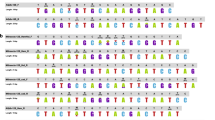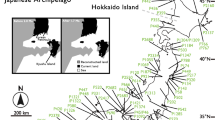Abstract
Transposable elements exert a significant effect on the size and structure of eukaryotic genomes. Tc1/mariner superfamily elements represent the widely distributed and highly variable group of DNA transposons. Tc1/mariner elements include TLE/DD34-38E, MLE/DD34D, maT/DD37D, Visitor/DD41D, Guest/DD39D, mosquito/DD37E, and L18/DD37E families, all of which are well or less scarcely studied. However, more detailed research into the patterns of prevalence and diversity of Tc1/mariner transposons enables one to better understand the coevolution of the TEs and the eukaryotic genomes. We performed a detailed analysis of the maT/DD37D family in Cnidaria. The study of 77 genomic assemblies demonstrated that maT transposons are found in a limited number of cnidarian species belonging to classes Cubozoa (1 species), Hydrozoa (3 species) и Scyphozoa (5 species) only. The identified TEs were classified into 5 clades, with the representatives from Pelagiidae (class Scyphozoa) forming a separate clade of maT transposons, which has never been described previously. The potentially functional copies of maT transposons were identified in the hydrae. The phylogenetic analysis and the studies of distribution among the taxons and the evolutionary dynamics of the elements suggest that maT transposons of the cnidarians are the descendants of several independent invasion events occurring at different periods of time. We also established that the TEs of mosquito/DD37E family are found in Hydridae (class Hydrozoa) only. A comparison of maT and mosquito prevalence in two genomic assemblies of Hydra viridissima revealed obvious differences, thus demonstrating that each individual organism might carry a unique mobilome pattern. The results of the presented research make us better understand the diversity and evolution of Tc1/mariner transposons and their effect on the eukaryotic genomes.







Similar content being viewed by others
Data availability
The datasets generated during and/or analysed during the current study are available in the Genbank repository and are also included in supplementary information files.
References
Arkhipova I, Meselson M (2000) Transposable elements in sexual and ancient asexual taxa. Proc Natl Acad Sci U S A 97(26):14473–14477. https://doi.org/10.1073/pnas.97.26.14473
Arkhipova IR, Yushenova IA (2019) Giant transposons in eukaryotes: is bigger better? Genome Biol Evol 11:906–918. https://doi.org/10.1093/gbe/evz041
Blumenstiel JP (2019) Birth, school, work, death, and resurrection: the life stages and dynamics of transposable element proliferation. Genes 10(5):336. https://doi.org/10.3390/genes10050336
Bourque G, Burns KH, Gehring M, Gorbunova V, Seluanov A, Hammell M, Imbeault M, Izsvak Z, Levin HL, Macfarlan TS, Mager DL, Feschotte C (2018) Ten things you should know about transposable elements. Genome Biol 19:199. https://doi.org/10.1186/s13059-018-1577-z
Bowen NJ, Jordan IK (2007) Exaptation of protein coding sequences from transposable elements. Genome Dyn 3:147–162
Buchan DWA, Jones DT (2019) The PSIPRED Protein Analysis Workbench: 20 years on. Nucleic Acids Res 47:402–407. https://doi.org/10.1093/nar/gkz297
Carla EC, Pagliara P, Piraino S, Boero F, Dini L (2003) Morphological and ultrastructural analysis of Turritopsis nutricula during life cycle reversal. Tissue Cell 35(3):213–222
Casacuberta E, González J (2013) The impact of transposable elements in environmental adaptation. Mol Ecol 22:1503–1517. https://doi.org/10.1111/mec.12170
Claudianos C, Brownlie J, Russell R, Oakeshott J, Whyard S (2002) maT - a clade of transposons intermediate between mariner and Tc1. Mol Biol Evol 19:2101–2109. https://doi.org/10.1093/oxfordjournals.molbev.a004035
Dindhoria K, Monga I, Thind AS (2022) Computational approaches and challenges for identification and annotation of non-coding RNAs using RNA-Seq. Funct Integr Genomics 22(6):1105–1112. https://doi.org/10.1007/s10142-022-00915-y
Dupeyron M, Baril T, Bass C, Hayward A (2020) Phylogenetic analysis of the Tc1/mariner superfamily reveals the unexplored diversity of pogo-like elements. Mob DNA 11:21. https://doi.org/10.1186/s13100-020-00212-0
Feschotte C, Pritham EJ (2007) DNA transposons and the evolution of eukaryotic genomes. Annu Rev Genet 41:331–368
Gao B, Zong W, Miskey C, Ullah N, Diaby M, Chen C, Wang X, Ivics Z, Song C (2020) Intruder (DD38E), a recently evolved sibling family of DD34E/Tc1 transposons in animals. Mob DNA 11(1):32. https://doi.org/10.1186/s13100-020-00227-7
Hoang DT, Chernomor O, von Haeseler A, Minh BQ, Vinh LS (2018) UFBoot2: Improving the ultrafast bootstrap approximation. Mol Biol Evol 35(2):518–522. https://doi.org/10.1093/molbev/msx281
Ivics Z, Hackett PB, Plasterk RH, Izsvak Z (1997) Molecular reconstruction of sleeping beauty, a Tc1-like transposon from fish, and its transposition in human cells. Cell 91:501–510. https://doi.org/10.1016/S0092-8674(00)80436-5
Ivics Z, Izsvák Z (2015) Sleeping Beauty transposition. Microbiol Spectr 3(2):MDNA3-0042-2014. https://doi.org/10.1128/microbiolspec.MDNA3-0042-2014
Juliano CE, Reich A, Liu N, Gotzfried J, Zhong M, Uman S, Reenan RA, Wessel GM, Steele RE, Lin H. 2014. PIWI proteins and PIWI-interacting RNAs function in Hydra somatic stem cells. Proc Natl Acad Sci U S A 111(1): 337-342. doi: https://doi.org/10.1073/pnas.1320965111.
Kalyaanamoorthy S, Minh BQ, Wong TKF, von Haeseler A, Jermiin LS (2017) ModelFinder: fast model selection for accurate phylogenetic estimates. Nat Methods 14:587–589. https://doi.org/10.1038/nmeth.4285
Kapitonov VV, Jurka J (2008) A universal classification of eukaryotic transposable elements implemented in Repbase. Nat Rev Genet 9:411–412. https://doi.org/10.1038/nrg2165-c1
Kidwell MG, Lisch DR (2000) Transposable elements and host genome evolution. Trends Ecol Evol 15(3):95–99. https://doi.org/10.1016/s0169-5347(99)01817-0
Kimura M (1980) A simple method for estimating evolutionary rates of base substitutions through comparative studies of nucleotide sequences. J Mol Evol 16(2):111–120
Kojima KK (2020) Structural and sequence diversity of eukaryotic transposable elements. Genes Genet Syst 94(6):233–252. https://doi.org/10.1266/ggs.18-00024
Malone CD, Hannon GJ (2009) Small RNAs as guardians of the genome. Cell 136(4):656–668. https://doi.org/10.1016/j.cell.2009.01.045
Martinez DE (1998) Mortality patterns suggest lack of senescence in hydra. Exp Gerontol 33(3):217–225
Melo ES, Wallau GL (2020) Mosquito genomes are frequently invaded by transposable elements through horizontal transfer. PLoS Genet 16(11):e1008946. https://doi.org/10.1371/journal.pgen.1008946
Nagy Z, Szabó M, Chandler M, Olasz F (2004) Analysis of the N-terminal DNA binding domain of the IS30 transposase. Mol Microbiol 54(2):478–488. https://doi.org/10.1111/j.1365-2958.2004.04279.x
Nguyen L-T, Schmidt HA, von Haeseler A, Minh BQ (2015) IQ-TREE: a fast and effective stochastic algorithm for estimating maximum-likelihood phylogenies. Mol Biol Evol 32:268–274. https://doi.org/10.1093/molbev/msu300
Plasterk RH, Izsvák Z, Ivics Z (1999) Resident aliens: the Tc1/mariner superfamily of transposable elements. Trends Genet 15(8):326–332. https://doi.org/10.1016/s0168-9525(99)01777-1
Puzakov MV, Puzakova LV (2022) Prevalence, diversity, and evolution of L18 (DD37E) transposons in the genomes of Cnidarians. Mol Biol 56:424–436. https://doi.org/10.1134/S0026893322030104
Puzakov MV, Puzakova LV, Cheresiz SV, Sang Y (2021) The IS630/Tc1/mariner transposons in three ctenophore genomes. Mol Phylogenet Evol 163:107231. https://doi.org/10.1016/j.ympev.2021.107231
Regev A, Lamb MJ, Jablonka E (1998) The role of DNA methylation in invertebrates: developmental regulation or genome defense? Mol Biol Evol 15(7):880–891
Ren Y (2022) Regulatory mechanism and biological function of UHRF1-DNMT1-mediated DNA methylation. Funct Integr Genomics 22(6):1113–1126. https://doi.org/10.1007/s10142-022-00918-9
Robertson HM (1997) Multiple Mariner transposons in flatworms and hydras are related to those of insects. J Hered 88(3):195–201. https://doi.org/10.1093/oxfordjournals.jhered.a023088
Ronquist F, Teslenko M, van der Mark P, Ayres D, Darling A, Höhna S, Larget B, Liu L, Suchard MA, Huelsenbeck JP (2012) MrBayes 3.2: efficient Bayesian phylogenetic inference and model choice across a large model space. Syst Biol 61:539–542. https://doi.org/10.1093/sysbio/sys029
Ross RJ, Weiner MM, Lin H (2014) PIWI proteins and PIWI-interacting RNAs in the soma. Nature 505(7483):353–359. https://doi.org/10.1038/nature12987
Rousseau P (2004) The helix-turn-helix motif of bacterial insertion sequence IS911 transposase is required for DNA binding. Nucleic Acids Res 32:1335–1344. https://doi.org/10.1093/nar/gkh276
Schemberger MO, Nascimento VD, Coan R, Ramos É, Nogaroto V, Ziemniczak K, Valente GT, Moreira-Filho O, Martins C, Vicari MR (2019) DNA transposon invasion and microsatellite accumulation guide W chromosome differentiation in a Neotropical fish genome. Chromosoma 128(4):547–560. https://doi.org/10.1007/s00412-019-00721-9
Seipel K, Yanze N, Schmid V (2004) The germ line and somatic stem cell gene Cniwi in the jellyfish Podocoryne carnea. Int J Dev Biol 48(1):1–7
Shao H, Tu Z (2001) Expanding the diversity of the IS630-Tc1-mariner superfamily: discovery of a unique DD37E transposon and reclassification of the DD37D and DD39D transposons. Genetics 159:1103–1115
Shen D, Gao B, Miskey C, Chen C, Sang Y, Zong W, Wang S, Wang Y, Wang X, Ivics Z, Song C (2020) Multiple Invasions of Visitor, a DD41D family of Tc1/mariner transposons, throughout the evolution of vertebrates. Genome Biol Evol 12:1060–1073. https://doi.org/10.1093/gbe/evaa135
Sinzelle L, Izsvák Z, Ivics Z (2009) Molecular domestication of transposable elements: from detrimental parasites to useful host genes. Cell Mol Life Sci 66(6):1073–1093. https://doi.org/10.1007/s00018-009-8376-3
Sotero-Caio CG, Platt RN, Suh A, Ray DA (2017) Evolution and diversity of transposable elements in vertebrate genomes. Genome Biol Evol 9:161–177. https://doi.org/10.1093/gbe/evw264
Steele RE, David CN, Technau U (2011) A genomic view of 500 million years of cnidarian evolution. Trends Genet 27:7–13. https://doi.org/10.1016/j.tig.2010.10.002
Sturm Á, Ivics Z, Vellai T (2015) The mechanism of ageing: primary role of transposable elements in genome disintegration. Cell Mol Life Sci 72(10):1839–1847. https://doi.org/10.1007/s00018-015-1896-0
Tarailo-Graovac M, Chen N (2009) Using RepeatMasker to identify repetitive elements in genomic sequences. Curr Protoc Bioinformatics Chapter 4:4.10.1-4.10.14. https://doi.org/10.1002/0471250953.bi0410s25
Tellier M, Bouuaert CC, Chalmers R (2015) Mariner and the ITm superfamily of Transposons. Microbiol Spectr 3:MDNA3-0033-2014. https://doi.org/10.1128/microbiolspec.MDNA3-0033-2014
Ulupova YN, Puzakova LV, Puzakov MV (2023) Structure and diversity of Tc1/mariner DNA transposons in the genome of the jellyfish Aurelia aurita. Russ J Genet 59:147–156
Venner S, Feschotte C, Biémont C (2009) Dynamics of transposable elements: towards a community ecology of the genome. Trends Genet 25:317–323
Wallau GL, Ortiz MF, Loreto EL (2012) Horizontal transposon transfer in eukarya: detection, bias, and perspectives. Genome Biol Evol 4(8):689–699. https://doi.org/10.1093/gbe/evs055
Wang S, Diaby M, Puzakov M, Ullah N, Wang Y, Danley P, Chen C, Wang X, Gao B, Song C (2021) Divergent evolution profiles of DD37D and DD39D families of Tc1/mariner transposons in eukaryotes. Mol Phylogenet Evol 161:107143. https://doi.org/10.1016/j.ympev.2021.107143
Watanabe H, Hoang VT, Mattner R, Holstein TW (2009) Immortality and the base of multicellular life: lessons from cnidarian stem cells. Semin Cell Dev Biol 20(9):1114–1125. https://doi.org/10.1016/j.semcdb.2009.09.008
Wicker T, Sabot F, Hua-Van A, Bennetzen JL, Capy P, Chalhoub B, Flavell A, Leroy P, Morgante M, Panaud O, Paux E, SanMiguel P, Schulman AH (2007) A unified classification system for eukaryotic transposable elements. Nat Rev Genet 8(12):973–982. https://doi.org/10.1038/nrg2165
Wong WY, Simakov O, Bridge DM, Cartwright P, Bellantuono AJ, Kuhn A, Holstein TW, David CN, Steele RE, Martínez DE (2019) Expansion of a single transposable element family is associated with genome-size increase and radiation in the genus Hydra. Proc Natl Acad Sci U S A 116(46):22915–22917. https://doi.org/10.1073/pnas.1910106116
Yamada KD, Tomii K, Katoh K (2016) Application of the MAFFT sequence alignment program to large data - reexamination of the usefulness of chained guide trees. Bioinformatics 32:3246–3251. https://doi.org/10.1093/bioinformatics/btw412
Ying H, Hayward DC, Klimovich A, Bosch TCG, Baldassarre L, Neeman T, Forêt S, Huttley G, Reitzel AM, Fraune S, Ball EE, Miller DJ (2022) The Role of DNA methylation in genome defense in Cnidaria and other invertebrates. Mol Biol Evol 39(2):msac018. https://doi.org/10.1093/molbev/msac018
Zhang HH, Shen YH, Xiong XM, Han MJ, Zhang XG (2016) Identification and evolutionary history of the DD41D transposons in insect. Genes Genom 38:109–117
Zong W, Gao B, Diaby M, Shen D, Wang S, Wang Y, Sang Y, Chen C, Wang X, Song C (2020) Traveler, a new DD35E family of Tc1/Mariner transposons, invaded vertebrates very recently. Genome Biol Evol 12(3):66–76. https://doi.org/10.1093/gbe/evaa034
Funding
This research was funded by grants from the Russian Academy of Sciences (121041400077-1) and the National Natural Science Foundation of China (31671313).
Author information
Authors and Affiliations
Contributions
Puzakov M. conceived and designed the study. Puzakov M., Puzakova L., and Shi S. mined transposons, collected data, and performed the data analysis. Puzakov M. and Cheresiz S. wrote the manuscript. All authors have read and approved the final version of the manuscript.
Corresponding author
Ethics declarations
Competing interest
The authors declare no competing interests.
Additional information
Publisher’s note
Springer Nature remains neutral with regard to jurisdictional claims in published maps and institutional affiliations.
Rights and permissions
Springer Nature or its licensor (e.g. a society or other partner) holds exclusive rights to this article under a publishing agreement with the author(s) or other rightsholder(s); author self-archiving of the accepted manuscript version of this article is solely governed by the terms of such publishing agreement and applicable law.
About this article
Cite this article
Puzakov, M.V., Puzakova, L.V., Shi, S. et al. maT and mosquito transposons in cnidarians: evolutionary history and intraspecific differences. Funct Integr Genomics 23, 244 (2023). https://doi.org/10.1007/s10142-023-01175-0
Received:
Revised:
Accepted:
Published:
DOI: https://doi.org/10.1007/s10142-023-01175-0




